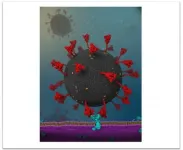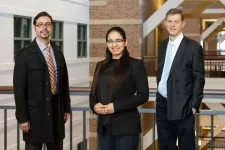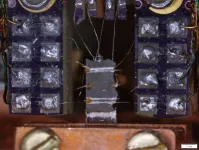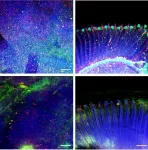(Press-News.org) Groundbreaking research from the University of South Australia has delivered world-first national-level guidelines to better inform children's physical activity and screen time in Outside School Hours Care (OSHC).
Developed with input from the OSHC sector, the guidelines aim to address growing concerns of children's sedentary behaviour marked by an increase in regular screen time. Research shows that 31-79 per cent of OSHC sessions are sedentary.
The guidelines specifically encourage energetic play while discouraging screen use:
Before School Care should schedule 45 minutes of physical activities and no more than 30 minutes of screen time.
After School Care should schedule 90 minutes of physical activities and no more than 60 minutes of screen time.
Vacation Care should schedule at least 2-3 hours of physical activities and no more than two hours of screen time across the whole day.
UniSA PhD candidate Rosa Virgara and Professor Carol Maher found that for children to achieve sufficient physical activity during OSHC, it should be provided on a 3:1 ratio - that is, that three times the opportunity for exercise is needed for children to achieve sufficient physical activity during OSHC.
In Australia, less than one in four children achieve the recommended 60 minutes of physical activity each day. On average, primary school-aged children (aged 5-14) spend more than two hours each day sitting or lying down for screen-based activities.
With about 10 per cent of Australian primary school children attending OSHC each year - and these hours accounting for 30 per cent of a child's potential daily recommended physical activity - the guidelines have the potential to affect many children on a regular basis.
UniSA's, Rosa Virgara says having the OSHC sector on board was critical to initiating change.
"Working closely with a broad range of OSHC stakeholders - including OSHC directors and educators, families, health and exercise experts - we've established consistent and workable guidelines to boost children's physical activity while also limiting screen time," Virgara says.
"The main physical activity concept across all aspects of OSHC was that it should be play-based and fun, with ample opportunity for free active outdoor play, rather than being structured and run like a physical education class.
"The emphasis on free play is consistent with other research that shows that over half of children's physical exercise is accumulated during outdoor free play.
"Screen time, if offered at all, should be limited and balanced with physical activities, while quiet sedentary activities should be available to allow children to self-regulate and move freely between active and quiet play."
Senior study author, Professor Carol Maher says that the next steps are to disseminate the new guidelines nationally, and develop resources that help OSHC staff understand their role in promoting healthy physical activity and screen use in OSHC, particular given the transient, casual basis of the OSHC workforce.
"To bring about these changes, OSHC staff will need to be supported with training to help them facilitate physical activities effectively," Prof Maher says.
"It will also be important to connect with children and families to help them understand and accept the new changes, and particularly in relation to screen time.
"Helping kids stay happy and healthy is a responsibility for which we all play a part. It's pleasing to see Australia's OSHC centres so keen to make positive change."
INFORMATION:
Notes to Editors:
Final Draft Physical Activity and Screen Time Guidelines for OSHC are available in a jpg.
The full article is available online: http://bit.ly/2NWkk8G
Virgara R, Phillips A, Lewis L, Richardson M & Maher C. Development of Australian physical activity and screen time guidelines for outside school hours care: an international Delphi study, International Journal of Behavioral Nutrition and Physical Activity volume 18, 2021.
Media contact: Annabel Mansfield T: +61 8 8302 0351 M: +61 417 717 504
E: Annabel.Mansfield@unisa.edu.au
Researcher: Rosa Virgara E: Rosa.Virgara@unisa.edu.au
Prof Carol Maher T: +61 8 8302 2315 E: Carol.Maher@unisa.edu.au
Arctic habitats have fascinated biologists for centuries. Their species-poor insect faunas, however, provide little reward for entomologists - scientists who study insects - to justify spending several weeks or even months in the hostile environments of tundra or polar deserts. As a result, data on insects from the High Arctic islands are often based on occasional collecting and remain scarce.
Vize Island, located in the northern part of the Kara Sea, is one of the least studied islands of the Russian High Arctic in terms of its biota. Scientists Dr Maria V. Gavrilo of the Arctic ...
WATERLOO, Ontario, March 29, 2021--A newly-published paper represents one of the most comprehensive reviews of advancements to come in contact lenses, catapulting the commonly-used medical device to applications well beyond refractive error correction.
Contact Lens Technologies of the Future (Jones L, et al.) is now in press from Contact Lens and Anterior Eye, the peer review journal of the British Contact Lens Association (BCLA). It joins nine other papers being printed in next month's special edition as part of the BCLA-led Contact Lens Evidence-based Academic Reports (CLEAR) series.
"There are a range of ...
Bioengineering researchers at Lehigh University have identified a previously unknown interaction between receptors in human cells and the spike, or "S," protein of SARS-CoV-2, the virus that causes COVID-19. This new information could aid in the development of new strategies to block SARS-CoV-2 entry into human cells.
X. Frank Zhang and Wonpil Im knew from recent studies that the interaction between the SARS-CoV-2 spike protein and angiotensin-converting enzyme 2 (ACE2) receptors in human cells is stronger than the interaction between the structurally identical spike protein of SARS-CoV-1, the virus that caused the 2002-2004 SARS outbreak, and the same receptors.
"Our goal was to characterize SARS-CoV-2 ...
CHAMPAIGN, Ill. -- Monitoring the progression of multiple sclerosis-related gait issues can be challenging in adults over 50 years old, requiring a clinician to differentiate between problems related to MS and other age-related issues. To address this problem, researchers are integrating gait data and machine learning to advance the tools used to monitor and predict disease progression.
A new study of this approach led by University of Illinois Urbana Champaign graduate student Rachneet Kaur, kinesiology and community health professor Manuel Hernandez and industrial ...
United Methodist churches -- whether the congregation is white or not -- have higher attendance when located within white neighborhoods. But racial diversity within a church is associated with higher average attendance over time, according to a new study.
"This is a startling contrast to previous research that reported multiracial congregations are less stable," said lead author Kevin D. Dougherty, Ph.D., associate professor of sociology at Baylor University.
The study is published in the journal Social Forces.
Previous research has found that it is difficult for congregations to build and sustain racially diverse memberships, ...
A new study suggests that clearing the invasive woody weed Prosopis julifora and grassland restoration in Baringo County, Kenya, may have significant financial benefits for local stakeholders and contribute to climate change mitigation.
Climate change, land degradation, and invasive alien species (IAS) such as Prosopis julifora are major threats to people's livelihoods in arid and semi-arid areas with each of these having negative impacts on ecosystem services - including vegetation biomass, which is a prime resource for pastoralists and agro-pastoralists.
The team, comprising PhD students and established scientists from four countries and different ...
LOS ALAMOS, N.M., March 26, 2021--New research has demonstrated that a magnetic uranium compound can have strong thermoelectric properties, generating four times the transverse voltage from heat than the previous record in a cobalt-manganese-gallium compound. The result unlocks a new potential for the actinide elements at the bottom of the periodic table and point to a fresh direction in research on topological quantum materials.
"We found that the large spin-orbit coupling and strong electronic correlations in a system of uranium-cobalt-aluminum doped with ruthenium resulted in a colossal anomalous Nernst conductivity," said Filip Ronning, lead investigator on the paper published today in Science Advances. Ronning ...
Presents a brief overview of the eight COVID-19 editorials published in DMPHP over the past year and using them as a framework to follow the evolution of the Pandemic over time. A review of the salient epidemiological and clinical dimensions of COVID-19 over time is given as well as a discussion of the medical and public health impacts of the disease and the interventions and policies put in place to contain and mediate the virus.
The concluding discussion questions the validity of the criteria used in selection of priority groups for vaccination in the US and notes that had a uniform program supporting the immunization of all over age 65 (accounting for 80% ...
How do different parts of the body communicate? Scientists at St. Jude are studying how signals sent from skeletal muscle affect the brain.
The team studied fruit flies and cutting-edge brain cell models called organoids. They focused on the signals muscles send when stressed. The researchers found that stress signals rely on an enzyme called Amyrel amylase and its product, the disaccharide maltose.
The scientists showed that mimicking the stress signals can protect the brain and retina from aging. The signals work by preventing the buildup of misfolded protein aggregates. Findings suggest that tailoring this signaling may potentially help combat neurodegenerative conditions like age-related dementia and Alzheimer's disease.
"We found that a stress response ...
The Environmental Protection Agency (EPA) is underestimating methane emissions from oil and gas production in its annual Inventory of U.S. Greenhouse Gas Emissions and Sinks, according to new research from the Harvard John A. Paulson School of Engineering and Applied Sciences (SEAS). The research team found 90 percent higher emissions from oil production and 50 percent higher emissions for natural gas production than EPA estimated in its latest inventory.
The paper is published in the journal Atmospheric Chemistry and Physics.
The research team, led by Joannes Maasakkers, a former graduate student at SEAS, developed a method to trace and map ...






